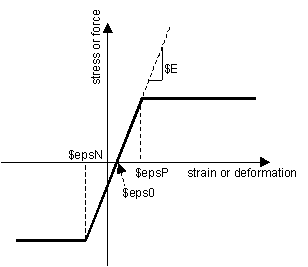ElasticBilin
This command is used to construct an elastic bilinear uniaxial material object. Unlike all other bilinear materials, the unloading curve follows the loading curve exactly.
Model.uniaxial(“ElasticBilin”, name, E, E2, eps2)
| E |
float
|
tangent in tension for stains: 0 <= strains \(\le\) epsP2
|
| E2 |
float
|
tangent when material in tension with strains > epsP2
|
| eps2 |
float
|
strain at which material changes tangent in tension. |
| EN1 |
float
|
optional, default = EP1. tangent in compression for stains:
0 < strains \(\le\)
epsN2
|
| EN2 |
float
|
optional, default = EP2. tangent in compression with
strains < epsN2
|
| epsN2 |
float
|
optional, default = -epsP2. strain at which material changes tangent in compression. |

NOTE:
eps0 can not be controlled. It is always zero.
Code Developed by: fmk